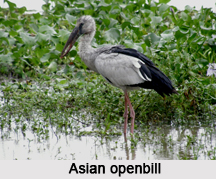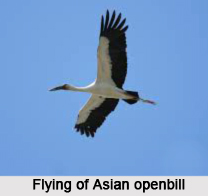 Asian Openbill or Asian openbill stork with a scientific name "Anastomus oscitans" is a large wading bird in the stork family Ciconiidae.
Asian Openbill or Asian openbill stork with a scientific name "Anastomus oscitans" is a large wading bird in the stork family Ciconiidae.
Concentration of Asian Openbill
Asian Openbill or Asian Openbill stork is found mainly in the Indian subcontinent and Southeast Asia. Young Asian Openbill disperses widely after fledging. These birds ringed at Bharatpur District of Rajasthan have been recovered 800 km east and a bird ringed in Thailand has been recovered 1500 km west in Bangladesh. The species is very rare in the Sind and Punjab regions of Pakistan, but widespread and common in India, Sri Lanka, Burma and Thailand.
Structure of Asian Openbill
Asian Openbill or Asian Openbill stork is greyish white with glossy black wings and tail and the adults have a gap between the arched upper mandible and recurved lower mandible. Young birds are born without this gap which is thought to be an adaptation that aids in the handling of snails, their main prey. Although resident within their range, they make long distance movements in response to weather and food availability.
Colour of Asian Openbill
Asian Openbill Stork is predominantly greyish white with glossy black wings and tail that have a green or purple sheen. The name is derived from the distinctive gap formed between the recurred lower and arched upper mandible of the beak in adult birds. Young birds do not have this gap. The cutting edges of the mandible have a fine brush like structure that is thought to give them better grip on the shells of snails. The mantle is black and the bill is horn-grey. At a distance, they can appear somewhat like a white stork or Oriental stork.
Legs of Asian Openbill
The short legs of Asian Openbill or Asian Openbill stork are pinkish to grey, reddish prior to breeding. Non-breeding birds have a smoky grey back instead of white. Young birds are brownish-grey and have a brownish mantle. Like other storks, the Asian openbill is a broad-winged soaring bird, which relies on moving between thermals of hot air for sustained flight. They are usually found in flocks but single birds are not uncommon. Like all storks, it flies with its neck outstretched. It is relatively small for a stork and stands at 68 cm height.
Habitats of Asian Openbill
The usual foraging habitats of Asian openbill or Asian openbill stork are inland wetlands and are only rarely seen along river banks and tidal flats. Asian openbills move widely in response to habitat conditions. Storks are regularly disoriented by lighthouses along the southeast coast of India on overcast nights between August and September. Asian openbill like many other storks forages at wetlands, reaching them by flying with wing flapping interspersed with gliding. During the warmer part of the day, they also soar on thermals and have a habit of descending rapidly into their feeding areas.
Behaviour of Asian Openbill
The groups of Asian openbills forage together in close proximity in shallow water or marshy ground on which they may walk with a slow and steady gait. The Asian openbill feeds mainly on large molluscs, especially Pila species, and they separate the shell from the body of the snail using the tip of the beak. The tip of the lower mandible of the beak is often twisted to the right. This tip is inserted into the opening of the snail and the body is extracted with the bill still under water.
Breeding Season of Asian Openbill
The breeding season of Asian Openbill is after the rains, during July to September in northern India and November to March in southern India and Sri Lanka. They may skip breeding in drought years. Asian Openbills are building a rough platform of sticks often on half-submerged trees typically laying two to four eggs.
Nestling of Asian Openbill
The nesting trees are shared with those of egrets, cormorants and darters. Nesting colonies are sometimes in highly disturbed areas such as inside villages. The nests are close to each other leading to considerable jostling among neighbours. Both parents take turns in incubation, the eggs hatching after about 25 days. The chicks of Asian openbill emerge with cream coloured down and are shaded by the loosely outspread and drooped wings of a parent Asian Openbill.











